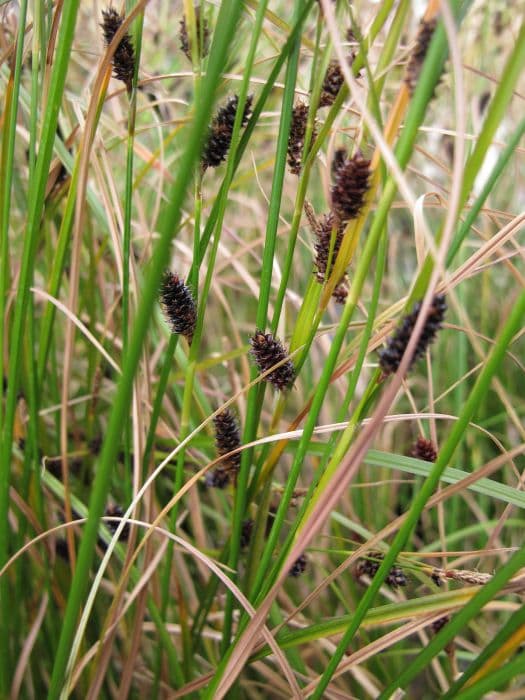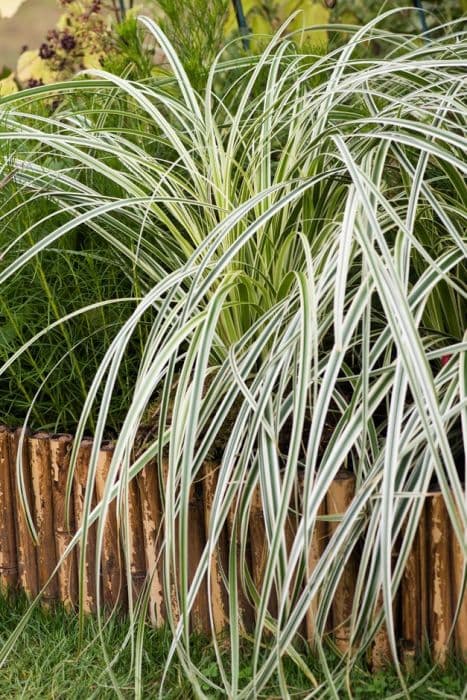Blue sedge Carex flacca











ABOUT
Blue sedge is a perennial grass-like plant with a cascading habit that forms dense tufts. Its foliage has a distinctive blue-green hue, sometimes with a powdery or glaucous surface, which can vary slightly in color intensity depending on environmental factors. The leaves are long and narrow, with slightly inrolled edges, giving them a somewhat wiry appearance. They emerge from the base of the plant and typically arch over as they mature, contributing to the plant's overall texture and visual interest. In the growing season, blue sedge produces inconspicuous flowers and seed heads that are not particularly ornamental and are often hidden among the foliage. These flowering stems, or culms, emerge somewhat upright but may lean or nod as they mature. The overall growth pattern of blue sedge is clump-forming, with the plant expanding outward from the center over time, though it is not overly aggressive. This sedge is valued more for its foliage and form rather than its flowers, making it a popular choice for groundcover and for adding a splash of color to gardens or naturalistic plantings.
About this plant
 Names
NamesFamily
Cyperaceae
Synonyms
Blue Sedge, Glaucous Sedge, Carnation Grass
Common names
Carex glauca, Carex flacca subsp. flacca, Carex flacca subsp. serrulata, Carex flacca var. flacca, Carex flacca var. serrulata, Carex alpina.
 Toxicity
ToxicityTo humans
Carex flacca, commonly known as glaucous sedge, does not have a significant level of toxicity to humans. It is not commonly reported to cause poisoning when touched or ingested. Nonetheless, ingestion of any plant material can sometimes cause a reaction in certain individuals due to personal sensitivities or allergies. In such cases, symptoms could include mild gastrointestinal discomfort, nausea, or vomiting. It is still advisable not to eat parts of ornamental plants due to potential unknowns regarding their effects on human health.
To pets
Carex flacca, commonly known as glaucous sedge, is not known to be significantly toxic to pets. It does not typically pose a threat of poisoning to dogs, cats, or other domestic animals if they ingest small amounts. However, as with humans, some pets may have individual allergies or sensitivities that could lead to mild gastrointestinal upset, such as vomiting or diarrhea. Care should be taken to monitor pets for any unusual symptoms if they are known to have nibbled on this plant, and contact a veterinarian if there are any concerns.
 Characteristics
CharacteristicsLife cycle
Perennials
Foliage type
Evergreen
Color of leaves
Blue-green
Flower color
Brown
Height
1-2 feet (30-60 cm)
Spread
1-2 feet (30-60 cm)
Plant type
Herb
Hardiness zones
5
Native area
Europe
Benefits
 General Benefits
General Benefits- Ornamental value: Adds aesthetic appeal to gardens with its blue-green foliage and graceful habit.
- Erosion control: The dense root system helps stabilize soil and prevent erosion on slopes and banks.
- Ground cover: Forms a low-growing mat that can suppress weeds and cover bare spots in the landscape.
- Habitat for wildlife: Provides shelter and nesting material for birds and small animals.
- Drought tolerance: Once established, it can tolerate periods of dry weather, reducing the need for supplemental watering.
- Low maintenance: Requires minimal care once established, making it a good choice for low-maintenance landscapes.
 Medical Properties
Medical PropertiesThis plant is not used for medical purposes.
 Air-purifying Qualities
Air-purifying QualitiesThis plant is not specifically known for air purifying qualities.
 Other Uses
Other Uses- Carex flacca, commonly known as blue sedge, can be used in basket weaving due to its long, flexible leaves.
- This plant is sometimes utilized as a natural dye, providing shades of brown and green, depending on the mordant used.
- Blue sedge is often planted in rain gardens due to its ability to tolerate and thrive in wet conditions.
- The fibrous roots can contribute to soil stabilization and prevent erosion on banks and slopes.
- It can be used in creating living roofs or green roofs because of its hardiness and low maintenance requirements.
- Since Carex flacca thrives in moist environments, it can be employed in constructed wetlands for wastewater treatment.
- Landscape designers use blue sedge for texture in rock gardens, where its bluish-green foliage contrasts well with stones and other alpines.
- The plant can serve as a natural lawn alternative in some settings, requiring less mowing and maintenance than traditional grasses.
- Blue sedge can be planted in butterfly gardens as it supports various caterpillar species which feed on the leaves.
- In some cultures, the seeds of Carex flacca are used as a food source for birds and small mammals in wildlife-friendly garden designs.
Interesting Facts
 Feng Shui
Feng ShuiThe Blue sedge is not used in Feng Shui practice.
 Zodiac Sign Compitability
Zodiac Sign CompitabilityThe Blue sedge is not used in astrology practice.
 Plant Symbolism
Plant Symbolism- Resilience: Carex flacca, also known as blue sedge, often symbolizes resilience due to its ability to thrive in various environments and adapt to different conditions.
- Flexibility: The plant's supple blades that bend without breaking represent the ability to withstand life's challenges without losing strength or determination.
- Protection: Blue sedge has been known to provide cover for smaller creatures, representing shelter and a symbol of protection and care.
- Adaptability: Given its versatility in growing in both wet and dry soils, Carex flacca symbolizes adaptability and the ability to prosper in changing circumstances.
- Grounding: As a sedge that forms dense tufts, it can be seen as a grounding force, representing stability and connection to the earth.
 Water
WaterThe Blue Sedge should be watered deeply to promote strong root development, usually receiving about 1 gallon per plant every week during the active growing season. In hotter and drier climates, increase watering frequency to twice a week, ensuring the soil doesn't dry out completely. During the winter months, watering can be reduced to every other week or even less frequently, depending on the soil moisture level. Allow the top inch of soil to dry out between waterings to prevent over-watering and potential root rot. It's essential to provide a consistent watering schedule to maintain a healthy Blue Sedge.
 Light
LightBlue Sedge thrives best in partial to full shade conditions. It should be planted in a spot that receives dappled sunlight or in an area that has bright indirect light. Avoid placing Blue Sedge under direct, harsh sunlight, as this can scorch the leaves and stress the plant.
 Temperature
TemperatureBlue Sedge does well in a wide range of temperatures and can survive in temperatures as low as 20 degrees Fahrenheit and as high as 80 degrees Fahrenheit. The ideal temperature for this plant to flourish is between 50 and 70 degrees Fahrenheit, which promotes healthy growth and maintains plant vigor.
 Pruning
PruningPruning Blue Sedge is not commonly required except to remove dead or damaged foliage. It is best to prune in late winter or early spring before new growth begins. Cut back the foliage to about 2-3 inches from the ground to encourage fresh, vigorous growth. Annual pruning will help maintain a tidy appearance and support the health of the Blue Sedge.
 Cleaning
CleaningNot needed
 Soil
SoilBlue sedge (Carex flacca) prefers a well-draining, peaty or sandy soil mix that retains moisture without becoming waterlogged. The ideal pH for blue sedge is slightly acidic to neutral, ranging from 5.5 to 7.0. A mix of two parts peat, one part perlite or sand, and one part garden soil could be a suitable soil blend for this grass-like plant.
 Repotting
RepottingBlue sedge typically does not require frequent repotting and can be done every 2-3 years, or when it has outgrown its current container. It's best to repot in spring or early summer when the plant is actively growing.
 Humidity & Misting
Humidity & MistingBlue sedge thrives in moderate to high humidity levels but is quite adaptable and can tolerate lower humidity environments. Ensuring good air circulation around the plant will help maintain healthy growth.
 Suitable locations
Suitable locationsIndoor
Place Blue sedge near a bright window and water regularly.
Outdoor
Partial shade, moist soil, avoid dry conditions.
Hardiness zone
4-9 USDA
 Life cycle
Life cycleCommonly known as Blue Sedge, Carex flacca begins its life cycle with seed germination, typically occurring in spring when soil conditions are moist and temperatures are favorable. The seedlings then develop into tufted plants, producing long, narrow leaves that are bluish-green in color. As it matures, Blue Sedge will develop flowering stems known as culms, which bear separate male and female spikelets; pollination is generally by wind, leading to fertilization. After fertilization, seeds develop in the female flowers and, once mature, are dispersed by wind, water, or animal movement to initiate a new cycle. In favorable conditions, Carex flacca can also propagate vegetatively through rhizomes, spreading horizontally to form dense clumps. The plant is perennial, meaning it can survive for several years, going through the process of growth, flowering, and seed production annually.
 Propogation
PropogationPropogation time
Spring-Early Summer
The most popular method of propagating Carex flacca, commonly known as blue sedge, is by division. This is typically done in the spring when the plant is actively growing. To propagate by division, gently lift the clump of blue sedge from the ground with a spade or fork and shake off excess soil. The clump should be divided into smaller sections, ensuring that each has a portion of the root system attached. These divisions can then be replanted immediately in moist, well-drained soil, spaced approximately 8 to 12 inches apart (or 20 to 30 centimeters). Care should be taken to water the new plants regularly until they are established and showing signs of new growth.


![Japanese sedge [Everest]](/_next/image?url=https%3A%2F%2Fplants-admin.emdemapps.com%2Fimages%2Fplants%2F%2Fimages%2F604b5b6de0548.png&w=640&q=75)






